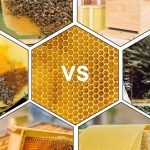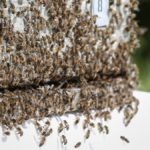In this article, we ask the question: How long do beehives last? This is not a straightforward question. We look at old beehives, new age beehives, and the biggest beehive ever found.
How Long Do Beehives Last?
This can be divided into two subheadings to reduce confusion.
How Long Do Beehive Boxes Last?
I have worked with beehives that have been in continuous use since the 1930s. These were made by Mann Lake bee equipment suppliers. The quality of workmanship on the boxes was exquisite and the timber is beautiful old-growth timber.
The amount of time a beehive box will last will really depend on a few factors. How well you look after it. On the environment and the climate. Whether you have pests that make holes in your hive. Whether bears gently massage the hive.
Modern plastic beehives will last for quite some time, but plastics tend to get brittle with age. I think there will be a limit of 10-20 years that these will last. This will depend on the quality of the materials used in construction. Remember that plastic that lasts forever is not something we want, as it will not biodegrade.
How Do Hives Of Bees Last?
Europe and North America
The dominant bees in this region are comprised of European honeybee races and are susceptible to a number of diseases that, without human assistance, will kill the bees in a year or two. Varroa mites are the main pest to which these bees have no real resistance.
Before the advent of this invasive pest in Europe and the USA, bees could occupy the same nesting site for millennia. It is not clear whether the bees would have done this without interruption, but we know that there are churches and castles and cliffs in Europe where specific sites were known to have had bees for hundreds to thousands of years.
Much like a city, a beehive is a continuation of individuals living in a specific spot. The oldest continuously occupied city in the world is thought to be Jericho. The people in the city now are not however the same people that were there 11 000 years ago.
In wild hives in nature, there is a build-up of bee silk in brood combs. This makes the cells that bees emerge from smaller and smaller with time. The cells also get dirtier and dirtier with time and more and more disease-prone.
In the natural cycle of beehive life, an occupied hive would last maybe 20-30 years and then collapse. Wax moths would eat the combs and clean the hive out. A year or two later another hive would move in, with a completely new queen and workers and continue living there. This makes us think the same bees were there all the time, but it is not the case.
This is a lovely story of a beehive in the USA.
African Bees
In Africa, bees have been recorded to actually remove bee silk from combs and reprocess them. The Cape Honeybee is completely genetically bizarre, and it is possible that there are beehives in Southern Africa that could have lived in cliffs continuously for thousands of years.

Old Beehives
I keep a few old beehives for decoration, but no longer keep bees in these.
There is always a risk that a beehive that is from before the 1970’s could have been treated with arsenic of similar wood preservatives. This poses a risk to you as a beekeeper handling these, and also to the consumers of your honey.
If you have an antique beehive, donate it to a museum, or use it as a decoration, after you have varnished it. Don’t sand it as the sanded material can poison you.
If the hive is painted, beware – old paints again often had lead in them.
New Age Beehives
As technology has progress we have been able to use new materials to make beehives. Plastic composite beehives are common around the world. Some people use metal beehives, concrete, and even clay beehives. To read more about what beehives can look like go here.
The Biggest Beehive Ever Found
There is a record in Zambia (then Northern Rhodesia) from the 1950’s that records a most curious event. To set the scene let’s describe the Miombo woodlands of Zambia. These are central African woodlands and are really vast. They contain an incredible density of beehives, and when the bees swarm, the forests are abuzz with thousands of swarms moving around looking for new homes.
Swarms
All races of bees produce swarms. As beekeepers, we control these. A swarm is part of the natural cycle of bees producing a new queen to keep the hive vigorous, and spreading to new nesting sites. The bees in African woodlands can produce 10 or more swarms per hive in a swarming season.
What Happens When Swarms Collide?
One fateful day in the Miombo woodlands, a swarm was flying along doing its own thing and it collided with another swarm. Confusion occurred and the two swarms merged. As fate would have it, this happened a few more times in other swarms flying in different directions converging on the same point. Suddenly a football-sized area of confused bees milled about in the air and eventually settled on a tree.
On the first day, this swarm covered a significant part of the tree and was recorded to be at least 10 feet long, and 14 feet wide. The next day, all swarms that passed were drawn into this behemoth because of the incredible amount of queen pheromone radiating out of it. Observers noted the occasional queen ball – a ball of bees killing a queen – on the ground.
As the season progressed the swarm became bigger and bigger and the region within 200 feet of the tree was dangerous to all life. The entire tree, measuring more than 20 feet wide and similar height was engulfed in honeycombs made in a haphazard fashion.
The honey flow came and went, and as the season ended, the hive gradually disintegrated leaving a mass of combs on the tree. This was a multi queen hive, and the social discontent of so many queens competing for genetic dominance resulted in a gradual disintegration of this most bizarre insect society.
We hope this has helped you answer a few questions about bees and avoid poisoning yourself with an antique hive. Please share with friends to spread the message.
Bee Hive Longevity FAQs
How long do beehive boxes last?
Beehive boxes can last for decades if well-maintained. Wooden hives, like those from Mann Lake, have been in use since the 1930s. Plastic hives typically last 10-20 years, though their longevity depends on material quality and environmental factors.
How does climate affect beehive longevity?
Beehives in extreme climates face faster degradation. In humid or wet conditions, wooden hives can rot, while in hot, sunny areas, plastic hives may become brittle, shortening their lifespan.
What causes a beehive to fail?
Several factors can lead to a beehive’s collapse, including diseases, pests like Varroa mites, and environmental wear. Regular maintenance and pest control can significantly extend the life of a beehive.
Do wild bee colonies last longer than managed ones?
Wild colonies typically survive 20-30 years before collapsing naturally due to environmental wear or disease buildup in combs. However, with Varroa mites and other diseases, wild bees often face faster declines than managed bees.
Can old beehives be dangerous?
Yes, old beehives may have been treated with toxic chemicals like arsenic or lead paint before modern safety standards. Handling or repurposing such hives can pose risks to both bees and humans.
What materials are used in modern beehives?
Today, beehives are made from a variety of materials, including wood, plastic composites, metal, and even concrete. Each material has its pros and cons in terms of longevity and sustainability.
How long do bees stay in a hive?
Bee colonies can occupy the same hive for years, even decades, as long as the conditions remain favorable. However, the bees within the hive will continuously renew through natural cycles, such as swarming.
What was the largest beehive ever recorded?
The largest known beehive was in Zambia, where multiple swarms merged into one massive hive. It measured over 20 feet wide and 10 feet long, enveloping an entire tree.
What happens to beehives in winter?
In colder climates, beehives enter a state of reduced activity, with bees clustering together for warmth. If properly insulated, hives can last through winter and be reused for many seasons.
How can I extend the life of my beehive?
To extend your hive’s lifespan, regularly inspect for signs of rot, pests, or wear, repaint or treat wooden hives with non-toxic sealants, and provide proper shelter from extreme weather conditions.

Dr. Garth A. Cambray is a Canadian/South African entrepreneur and beekeeper with 28 years of experience in apiculture and specializes in adding value to honey. His Ph.D. research developed a new advanced continuous fermentation method for making mead that has resulted in a number of companies globally being able to access markets for mead. His company, Makana Meadery, exports honey mead to the USA where it is available to discerning connoisseurs. He has also developed technologies to commercially manufacture organic honey vinegar in Zambia for export globally. He holds a few patents globally in the ethanol industry and believes in technology and knowledge transfer for human development and environmental sustainability. One of his proudest achievements is the fact that the wind farm he started at one of his old apiary sites has essentially made his hometown carbon neutral.






